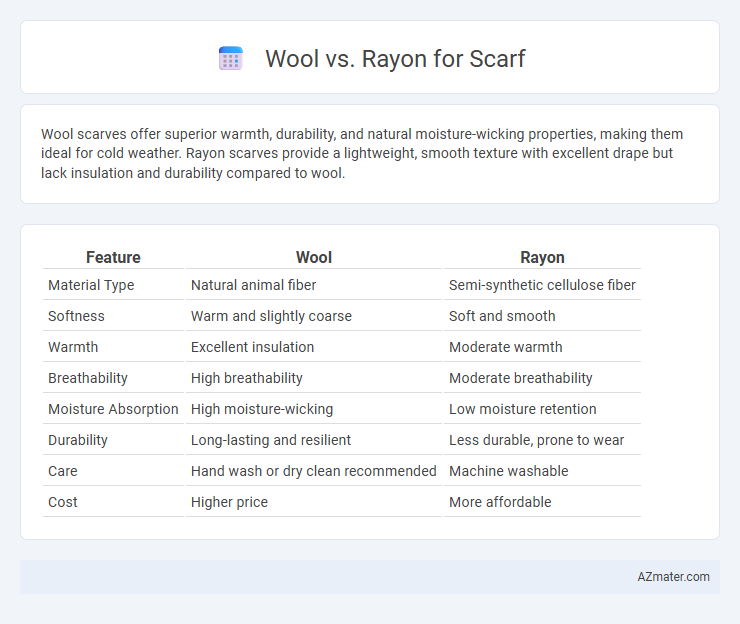Wool scarves offer superior warmth, durability, and natural moisture-wicking properties, making them ideal for cold weather. Rayon scarves provide a lightweight, smooth texture with excellent drape but lack insulation and durability compared to wool.
Table of Comparison
| Feature | Wool | Rayon |
|---|---|---|
| Material Type | Natural animal fiber | Semi-synthetic cellulose fiber |
| Softness | Warm and slightly coarse | Soft and smooth |
| Warmth | Excellent insulation | Moderate warmth |
| Breathability | High breathability | Moderate breathability |
| Moisture Absorption | High moisture-wicking | Low moisture retention |
| Durability | Long-lasting and resilient | Less durable, prone to wear |
| Care | Hand wash or dry clean recommended | Machine washable |
| Cost | Higher price | More affordable |
Introduction: Wool vs Rayon Scarves
Wool scarves provide superior warmth and natural moisture-wicking properties, making them ideal for cold climates. Rayon scarves offer a lightweight, silky texture with excellent breathability, suited for mild weather or fashion purposes. Choosing between wool and rayon depends on the desired balance of insulation, softness, and durability for scarf wear.
Material Composition: Wool and Rayon Explained
Wool is a natural fiber derived from sheep, known for its excellent insulation, moisture-wicking properties, and durability, making it ideal for warm, breathable scarves. Rayon, a semi-synthetic fiber made from regenerated cellulose pulp, offers a soft, smooth texture with high drapability but lacks wool's natural thermal insulation and water resistance. Scarves made from wool provide superior warmth and resilience, while rayon scarves excel in lightweight comfort and vibrant color retention.
Texture and Feel: Comfort Comparison
Wool scarves offer a naturally insulating and breathable texture, providing warmth with a soft yet slightly coarse feel that can vary by wool type. Rayon scarves deliver a smooth, silky texture that feels lightweight and cool against the skin, ideal for those seeking softness without added warmth. Comfort preferences depend on climate and skin sensitivity, with wool excelling in colder environments and rayon favored for gentle, breathable wear.
Breathability and Warmth
Wool excels in breathability and warmth due to its natural insulating fibers that trap air, keeping the wearer warm without causing overheating. Rayon, made from regenerated cellulose fibers, offers moderate breathability but lacks the natural insulation properties of wool, making it less effective in cold conditions. For scarves, wool provides superior temperature regulation and moisture-wicking capabilities, ideal for maintaining warmth in chilly weather.
Durability and Longevity
Wool scarves are renowned for their exceptional durability, maintaining integrity and warmth over years of regular use due to natural resilience and moisture-wicking properties. Rayon scarves, while soft and lightweight, tend to have lower durability as the semi-synthetic fibers can weaken with repeated washing and exposure to elements. Choosing wool ensures longer-lasting wear and resistance to pilling, making it a superior option for durability and longevity compared to rayon.
Care and Maintenance Requirements
Wool scarves require gentle hand washing with cold water and mild detergent or dry cleaning to maintain fiber integrity and prevent shrinkage. Rayon scarves demand delicate care, ideally hand washed in cold water and air dried, as the fabric is prone to stretching and weakening when exposed to heat or harsh detergents. Proper storage in a cool, dry place away from direct sunlight preserves the texture and longevity of both wool and rayon scarves.
Eco-Friendliness and Sustainability
Wool is a natural, biodegradable fiber derived from sheep, making it a renewable and eco-friendly choice for scarves due to its ability to decompose without polluting the environment. Rayon, made from cellulose fibers typically sourced from wood pulp, involves chemically intensive and energy-consuming production processes that can contribute to deforestation and water pollution, raising sustainability concerns. Choosing wool supports animal agriculture practices that can be managed sustainably, whereas rayon's eco-friendliness heavily depends on the sourcing and manufacturing methods, such as using certified sustainable wood and closed-loop production systems.
Price and Affordability
Wool scarves typically command higher prices due to the natural fiber's durability and insulating properties, making them a more significant investment compared to rayon. Rayon scarves are generally more affordable, offering a budget-friendly alternative with a soft feel but less warmth and longevity than wool. Choosing between wool and rayon depends on balancing initial cost with long-term use and comfort preferences.
Style and Color Options
Wool scarves offer rich texture and natural earth tones, ideal for classic and cozy winter styles, while rayon scarves provide a smooth, shiny finish with a wide array of vibrant colors and patterns suitable for trendy and lightweight layering. The natural fibers in wool create a timeless look with color variations that deepen over time, contrasting with rayon's ability to mimic silk's sheen, enhancing bold and diverse style choices. Selecting between wool and rayon for scarves depends on desired warmth, texture, and the color palette sought for versatile or statement accessories.
Which is Better for Scarves?
Wool offers superior warmth, breathability, and natural moisture-wicking properties, making it ideal for scarves in colder climates. Rayon, a semi-synthetic fiber, provides a softer texture and smoother drape but lacks the insulation and durability of wool. For scarves, wool is better suited to retain heat and resist wear, while rayon excels in lightweight, stylish scarves for mild weather.

Infographic: Wool vs Rayon for Scarf
 azmater.com
azmater.com